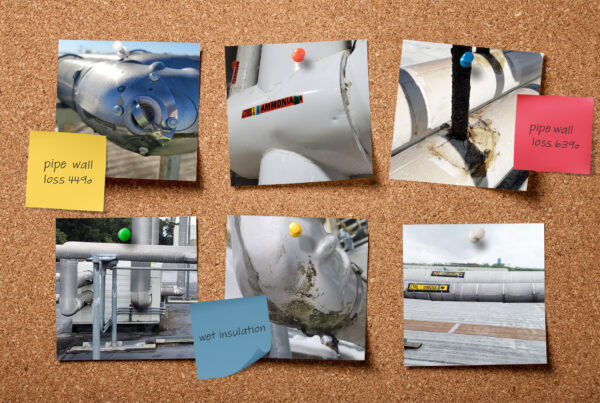Winning OSHA Over:
How the Small Details Help You Pass the Big Test
A Customer Story from In the Field
“Well, if you can’t explain why you didn’t do anything about the 40% wall loss indicated in this report, I’m going to cite you,” said the OSHA inspector.
by the team at GGS
November 28, 2016
“Well, if you can’t explain why you didn’t do anything about the 40% wall loss indicated in this report, I’m going to cite you,” said the OSHA inspector. He placed the report from our last system evaluation back on my desk and stared at me.
I could see the skepticism in his eyes and imagined he was already formulating thoughts about how many other flaws he would find in our facility. As I pondered the minimum $12,000 impact a citation would have, I wracked my brain for answers.
The dairy plant I manage contains an ammonia piping system that I had brought Gamma Graphics Services (GGS) in to inspect three years prior, and I had pulled their report to show the inspector. I had not looked at it in quite some time, but just as I remembered, the report was detailed and thorough, including visual representations to help me make sense of the data. Every finding was listed, but as he leafed through the binder, the inspector fixated on one particular measurement that had been flagged. I remembered discussing the results with Jim, the GGS engineer, when he gave me the report—but I couldn’t recall the reason there wasn’t maintenance performed on this particular indication.
“Why wasn’t any action item associated with this flag?” queried the OSHA inspector once again.
“One second. I think I know who can help answer that question,” I replied, trying to sound confident.
I called Jim and left him a desperate voicemail.
Before my panic could truly set in, my phone rang right back. It was Jim.
I closed my office door and put the phone on speaker. “Jim,” I began—a bit rushed—“I have an OSHA inspector here, and he wants to know why no action item was logged in our report regarding a location you flagged.”
Jim fished out a copy of the report on his end, and I could hear the smile in his voice as he began educating both the OSHA inspector and me.
“Ah, I see what was happening here,” he said, reassuringly. “If you look at the measurements in the report, you will see that we took seven readings along that line. All of the readings were nominal thickness except for that one, and we knew that was improbable.”
“Why?” interjected the OSHA inspector.
“Well, there’s more to it than just the reading,” continued Jim. “In our post-reading analysis, we determined the indication of wall loss wasn’t valid. The plant’s drawings of their pipes showed one schedule of pipe only along this line, but in reality this section of pipe was of a different wall thickness.”
“Moreover, that reading was taken within a valve group. Valve groups are often made separately from the remainder of the pipe. The pipe is thinner, but since it is welded, the valve group still meets standards.”
I saw the corners of the OSHA inspector’s mouth begin to curl up. I could tell he was surprised—in a good way—by what Jim was saying.
As his countenance changed, I realized something as well. I had been pleased with the report initially for its thorough nature, but I gained an extra level of appreciation when I found it could be combined with GGS’ expertise to turn a situation like this entirely around.
The data in the report, combined with the knowledge of the GGS engineers, completely re-created the discussion we had three years prior! Not only that, but Jim was perfectly willing to jump on a call and go to bat for me with the OSHA inspector. He didn’t just hide behind the report and expect me to be able to defend my plant to OSHA on my own.
“Wow, I didn’t realize initially just how much data was here,” noted the inspector, praising the amount of information that was documented in the report.
The remainder of the inspector’s visit was much more positive. We continued through the report, which categorized each set of information—wet insulation, possible schedule change, corroded piping, and visual observations—such as a handrails missing or stairways not up to par.
The depth of information gave the OSHA inspector some revelations of his own. “You know, it actually seems you are doing exactly the right things to make sure your plant is safe. I think you should consider joining our VPP Star Program.”
So in a span of 15 minutes, I had gone from fearing thousands of dollars in citations to considering joining OSHA’s program for top performers, sharing best practices for safety compliance with peers across the country.
That’s quite a turnaround. It saved me thousands of dollars, but beyond that, it confirmed our plant was doing the right things, by any standard.

